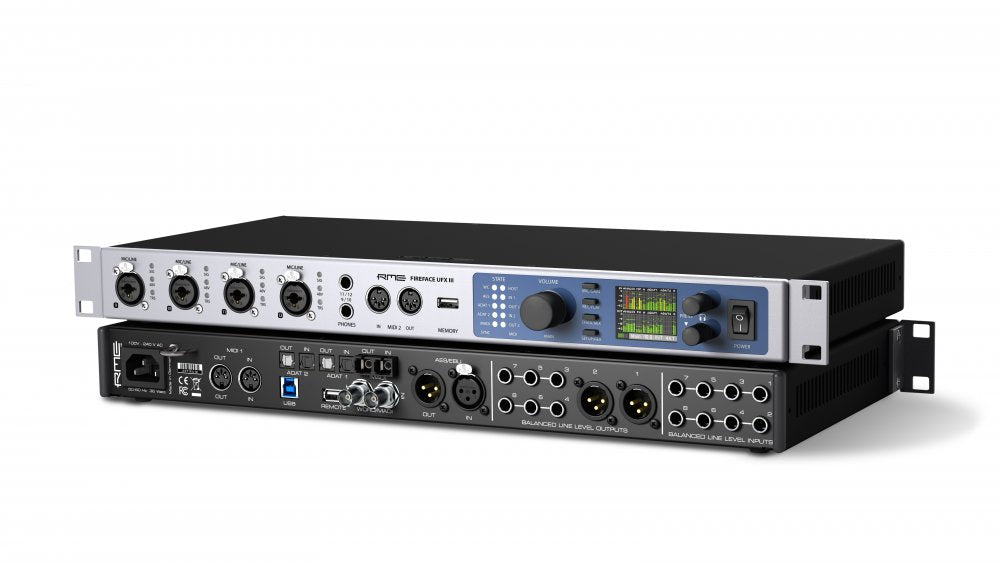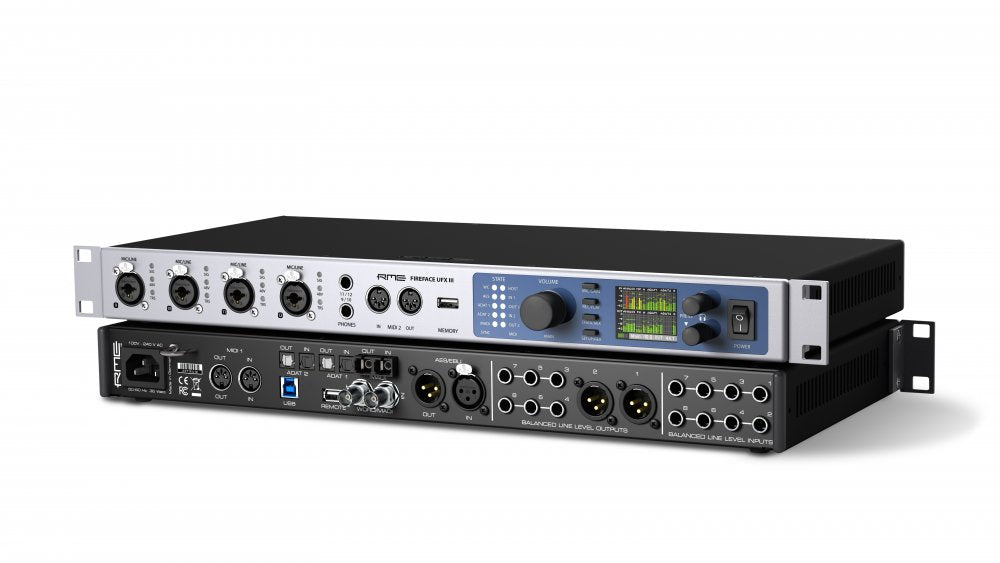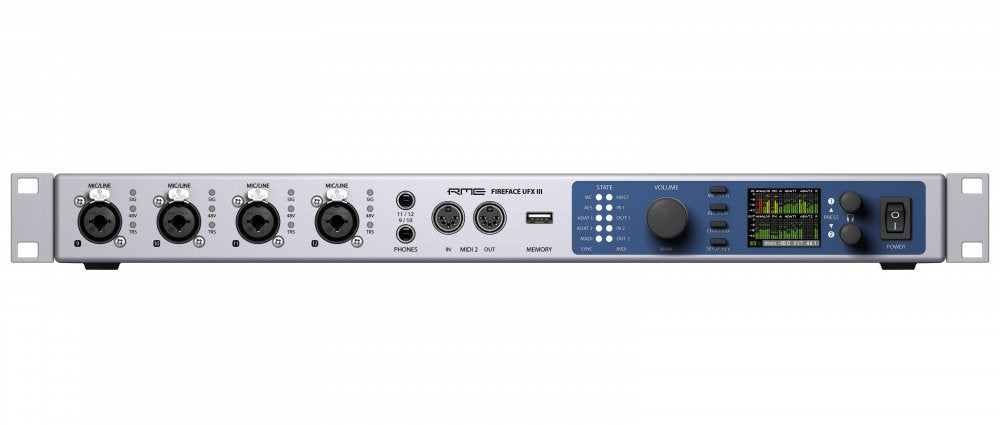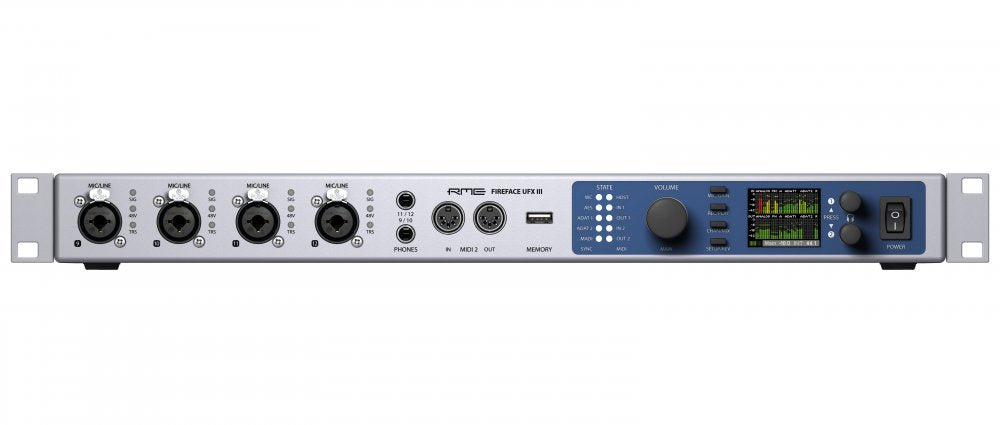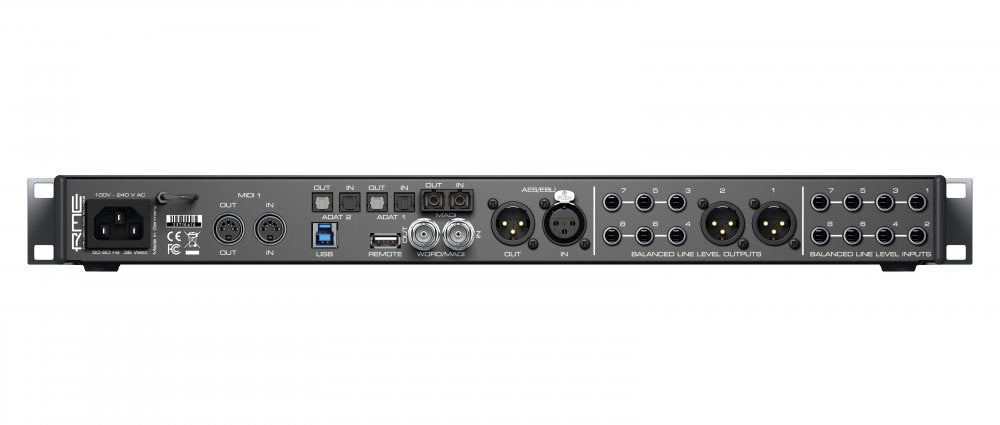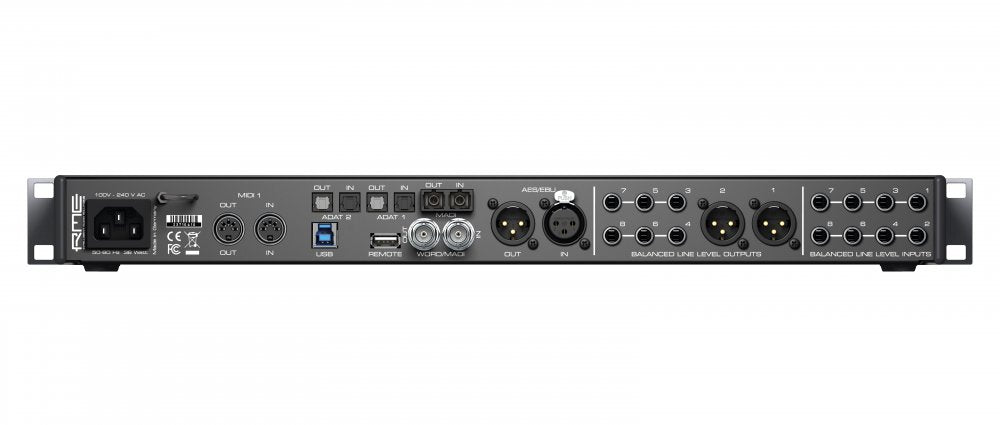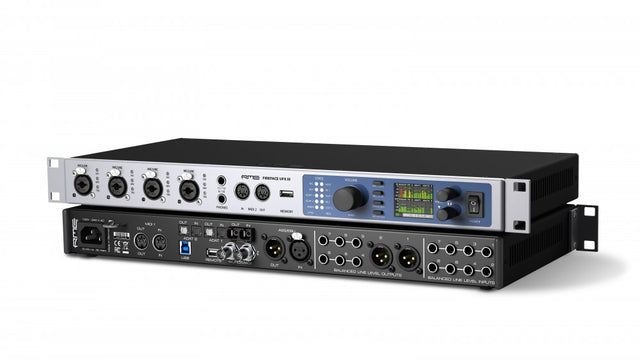Fireface UFX III
Delivery & Shipping
Delivery & Shipping
Free Shipping in Canada with orders over $200. Conditions apply. View details here.
Financing
Financing
Affirm
Break your purchase into easy monthly payments, quick approval and no hidden fees.
Click here for more info.
Equilease
Ideal for larger purchases, Equilease offers customized leasing solutions to fit your business needs.
Click here for more info.
Returns & Policy
Returns & Policy
You can review our terms and conditions here
Description
Description
The Multichannel Flagship Interface The Fireface UFX III is the center of any multitrack studio, handling up to 94 channels I/O with ease. Its unprecedented flexibility, compatibility, the inclusion of DURec (Direct USB Recording) and RME's famous low latency hardware and driver designs guarantee flawless operation in any mode and application.
Packed with professional features, including SteadyClock FS, MADI I/O (64 channels), a powerful DSP, USB 3.0 (full 94 channel I/O Class Compliant ready), TotalMix FX, Direct USB Recording, and support for the Advanced Remote Control USB (available separately), the Fireface UFX III is the professional's preferred tool for multitrack recording, mixing and mastering.
The Fireface UFX III is based on a newly developed analog and digital board. While the analog board offers, for example, DC-coupled analog outputs as well as new AD and DA converters with improved THD+N value, the digital board also enables interesting new features thanks to updated high-tech components.
Powerful USB 3 Performance The front panel of the Fireface UFX III provides four high-performance XLR/TRS combo inputs for microphone, instrument and line signals, two stereo headphone jacks with +19 dBu output level, MIDI I/O, and a USB port. In combination with the DURec function (Direct USB Recording), the USB port allows independent recording of selected input and output signals (up to 80 channels) to a connected USB storage medium.
The rear panel reveals the full connectivity of the Fireface UFX III. Besides another MIDI I/O, the two optical ADAT I/Os, an AES/EBU I/O, and eight balanced analog outputs with line level (including XLR stereo monitor outputs) are available. With the new Multi-Mode, the two ADAT I/Os can be used as separate optical SPDIF inputs and outputs in addition to the AES I/O. Furthermore, the Fireface UFX III offers an optical MADI interface (SC) with 64 bidirectional channels. The Word Clock connectors (BNC) work as additional coaxial MADI input and output if required.
Comprehensive MADI Connectivity The Fireface UFX III opens the doors to a host of RME and 3rd party digital and analog I/O solutions. Expanding your analog channel count, the ability to route/mix within the digital domain through numerous sources presents many flexible options. Multiple external MADI devices can also be connected in series.
To further enhance MADI flexibility, the Fireface UFX III boasts some typical RME-style features. For example in USB 2 mode, which is limited to 30 channels I/O (12 analog plus 16 ADAT plus AES), the MADI I/O is still available via RME's integrated hardware mixer TotalMix FX. Word Clock I/O (BNC) can be switched to MADI I/O (coaxial), and a special split mode even supports the use of both MADI I/Os simultaneously, with 32 channel each on optical and coaxial.
Powerful Applications for Mixing, Monitoring and Measurement included The Fireface UFX III comes with the TotalMix FX DSP mixer offering comprehensive routing and monitoring options, as well as the DIGICheck Analyzer allowing to measure and analyze the digital data feed in both directions with maximum precision. TotalMix FX can completely replace an external mixer, enabling the creation of multiple latency-free monitor mixes with EQ, Dynamics, Reverb and Delay for any outputs, incl. main monitors and headphone mixes for musicians.
The additional TotalMix Remote is a remote control for TotalMix FX, to control the hardware mixer and effects in RME audio interfaces. TotalMix Remote mirrors the current state of the host system on the iPad and Windows/Mac computers - the entire mixing state, the complete routing, all FX settings, up to the level meters, and everything in real-time. Easily adjust all the mixer and FX settings from a distance, via Ethernet and WiFi.
DC-Coupled Outputs - CV/Gate Voltage Control Most audio interfaces are traditionally designed with what is called 'AC-coupled outputs', where capacitors are used to filter out any extreme low frequencies.
Whilst these frequencies are generally considered undesirable for audio - eating into headroom and potentially causing damage to other equipment - one instance where DC-coupling remains desirable is the world of modular synthesizers, where static or slow-moving signals are used for control over various parameters such as pitch note values or LFOs.
All of the Fireface UFX III's line-level outputs are fully DC-coupled, allowing for the sending of control voltages (CV) or Gate information to modular synthesizers (such as the popular Eurorack and Moog/MOTM/Synthesizers formats) and other studio hardware.
USB 3 Class Compliant Audio The Fireface UFX III operates in two different modes: driver-based USB 3 and Class Compliant. The Class Compliant mode is a standard that is natively supported by operating systems like Windows, Mac OSX and Linux distributions. No proprietary drivers are required, the device will be directly recognized when the CC firmware is loaded.
The Fireface UFX III is RME's first audio interface with full USB 3.0 support in Class Compliant Mode. This makes all channels available in driverless operation for Linux, Mac and iPadOS. An iPad Pro with USB C can manage up to 94 channels for recording and playback in TotalMix FX for iPad and on system level.
ARC USB Remote Control - Plug'n Play Plus The optional available ARC USB connects to your computer via USB, and talks to TotalMix FX directly. It has 15 freely assignable and illuminated buttons, one encoder wheel, and a TS jack to connect a foot switch.
The ARC USB is a USB 1.1 MIDI remote control for the Fireface UFX III. Thanks to operating as a UAC 1 class device, it is natively compatible to Windows and Mac OS X. As soon as it is present in the operating system, TotaIMix FX will automatically detect the ARC USB, and communicate with it via simple MIDI remote commands to control the UFX III.
DURec (Direct USB Recording) DURec is an integrated digital recorder for all inputs and outputs directly to USB memory devices via the front USB port. The Fireface UFX III records on USB thumb drives or hard drives with up to 2 TB capacity. The recording functionality is provided by the internal DSP, and is therefore independent from a connected Windows or Mac computer. The Direct USB Recording converts the Fireface UFX Series both into a stand-alone field recorder and a powerful multichannel live player for previous recordings, e. g. for virtual sound checks. Live concerts, band rehearsals or spontaneous jam sessions can be directly recorded and played back from the medium - even completely stand-alone without computer or software.
Features
Features
Specifications
Specifications
Payment & Security
Your payment information is processed securely. We do not store credit card details nor have access to your credit card information.
